
The Saint Helena olive is an extinct species of flowering plant. It is the only member of the genus Nesiota. It was endemic to the island of Saint Helena in the South Atlantic Ocean. Despite its name, it is unrelated to the true olive, but is instead a member of the family Rhamnaceae, the family which contains buckthorns and jujube. The last remaining tree in the wild died in 1994, and the last remaining individual in cultivation died in December 2003, despite conservation efforts. It is thus a prime example of recent plant extinction. The Saint Helena olive belongs to the tribe Phyliceae, which are mostly endemic to Southern Africa.
Lachanodes arborea, the she cabbage tree, is a small tree in the family Asteraceae. It is an endangered endemic of the island of Saint Helena in the South Atlantic Ocean. It is now extinct in the wild.
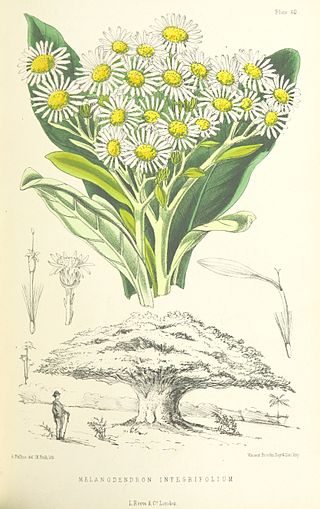
Melanodendron is a genus of trees in the family Asteraceae, with only one species, Melanodendron integrifolium, native to the island of Saint Helena. It is related to the Saint Helenan gumwoods and is the most common of the remaining cabbage tree species of Saint Helena, although it is considered endangered due to the restricted population size.
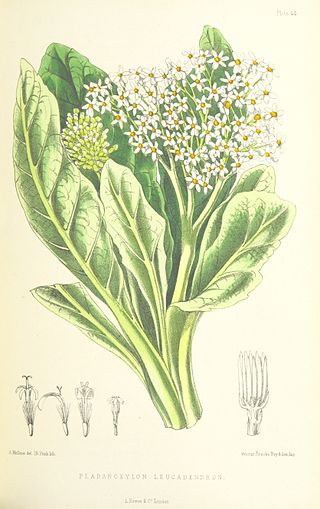
Pladaroxylon is a genus of trees in the tribe Senecioneae within the family Asteraceae.

Trochetiopsis erythroxylon, the Saint Helena redwood, is a species of plant, now extinct in the wild. It was formerly abundant enough in the upland parts of the island of Saint Helena for early settlers in the 17th century to use the timber to make their homes. It became extinct in the 1950's due to deforestation as its habitat was cleared to make way for pasture, timber and fuel.

Trochetiopsis ebenus, the dwarf ebony or Saint Helena ebony, is a species of flowering plant that is endemic to the island of Saint Helena in the southern Atlantic Ocean. It is not related to the ebony of commerce, but is instead a member of the mallow family, Malvaceae. Saint Helena ebony is now critically endangered in the wild, being reduced to two wild individuals on a cliff, but old roots are sometimes found washed out of eroding slopes. These are collected on the island a used for inlay work, an important craft on Saint Helena. A related species, Trochetiopsis melanoxylon is now completely extinct.

Commidendrum robustum, the Saint Helena gumwood, is a species of tree endemic to Saint Helena, Ascension and Tristan da Cunha. Though it is now comparatively rare, it was once one of the most abundant trees of mid-elevations of the island of Saint Helena in the South Atlantic Ocean. A small tree to 7–8 m, it was cut extensively for fuel in the early years of settlement of the island by the English East India Company. It has given its name to certain placenames on the island such as "Gumwoods". It is one of several species in the endemic genus Commidendrum.

Petrobium is a genus in the family Asteraceae.

Berula is a cosmopolitan genus of flowering plants in the family Apiaceae, whose species are known as water parsnips, as are some other plants in Apiaceae such as Sium latifolium and Sium suave. It is easily confused with the highly toxic water hemlock.
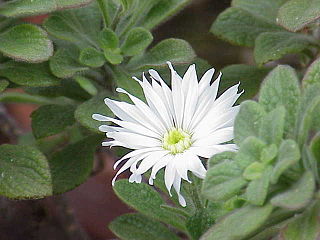
Commidendrum rugosum, known as scrubwood, is a species of flowering plant in the family Asteraceae.

Helosciadium bermejoi, synonym Apium bermejoi, is a critically endangered species of flowering plant in the family Apiaceae.
Sium burchellii, known commonly as dwarf jellico, is a species of flowering plant in the family Apiaceae. It is endemic to Saint Helena. It grows on steep island cliffs. It is threatened by the fragmentation of its small populations, introduced species of plants, landslides, and possibly hybridization with Sium bracteatum.
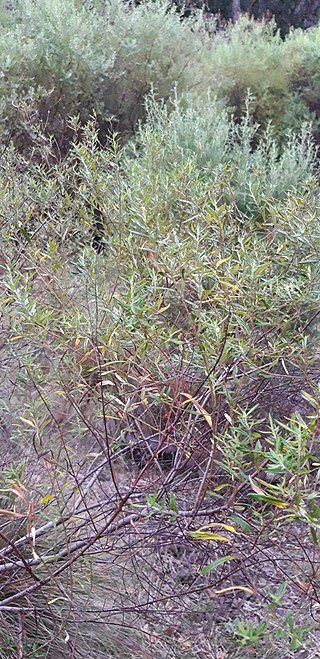
Phylica polifolia, also called rosemary or Saint Helena rosemary, is a species of plant in the family Rhamnaceae. It is endemic to Saint Helena. Its natural habitats are rocky areas and rocky shores.
Sium bracteatum is a species of flowering plant in the family Apiaceae. It is endemic to Saint Helena. It is protected in Diana's Peak National Park, but proper management practices have not yet been established. It is threatened by fragmentation of its populations, introduced species of plants, and possibly hybridization with Sium burchellii.
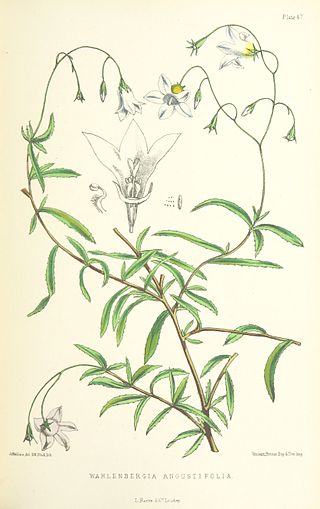
Wahlenbergia angustifolia, also called small bellflower, is a species of plant in the family Campanulaceae. It is endemic to Saint Helena. Its natural habitat is rocky areas. It is endangered because of habitat loss.
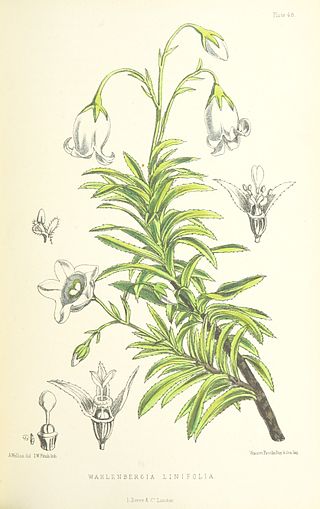
Wahlenbergia linifolia, the large bellflower, is a species of plant in the family Campanulaceae. It is endemic to Saint Helena. Its natural habitat is rocky areas. It is threatened by habitat loss.
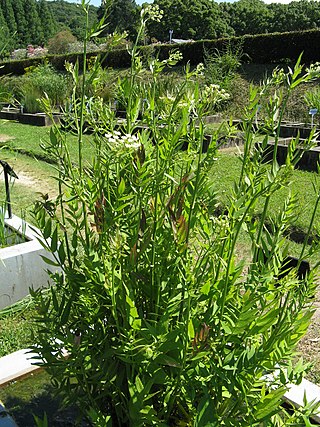
Sium suave, the water parsnip or hemlock waterparsnip, is a perennial wildflower in the family Apiaceae. It is native to many areas of both Asia and North America. The common name water parsnip is due to its similarity to parsnip and its wetland habitat. The alternate common name hemlock waterparsnip is due to its similarity to the highly poisonous spotted water hemlock.
Water parsnip is a common name given to a number of flowering plants in the family Apiaceae, including those from the Berula and Sium genera.

Berula erecta, known as lesser water-parsnip or cutleaf waterparsnip or narrow-leaved water-parsnip, is a member of the carrot family. Growing to around 1 m (3 ft) tall, it is found in or by water. It is widespread across much of Europe, Asia, Australia, and North America.

Helosciadium nodiflorum, fool's watercress, is a flowering plant found in ditches or streams, as well as fresh and brackish-water wetlands native to western Europe. It is not poisonous to humans but it could be easily confused with the allegedly poisonous lesser water parsnip.















